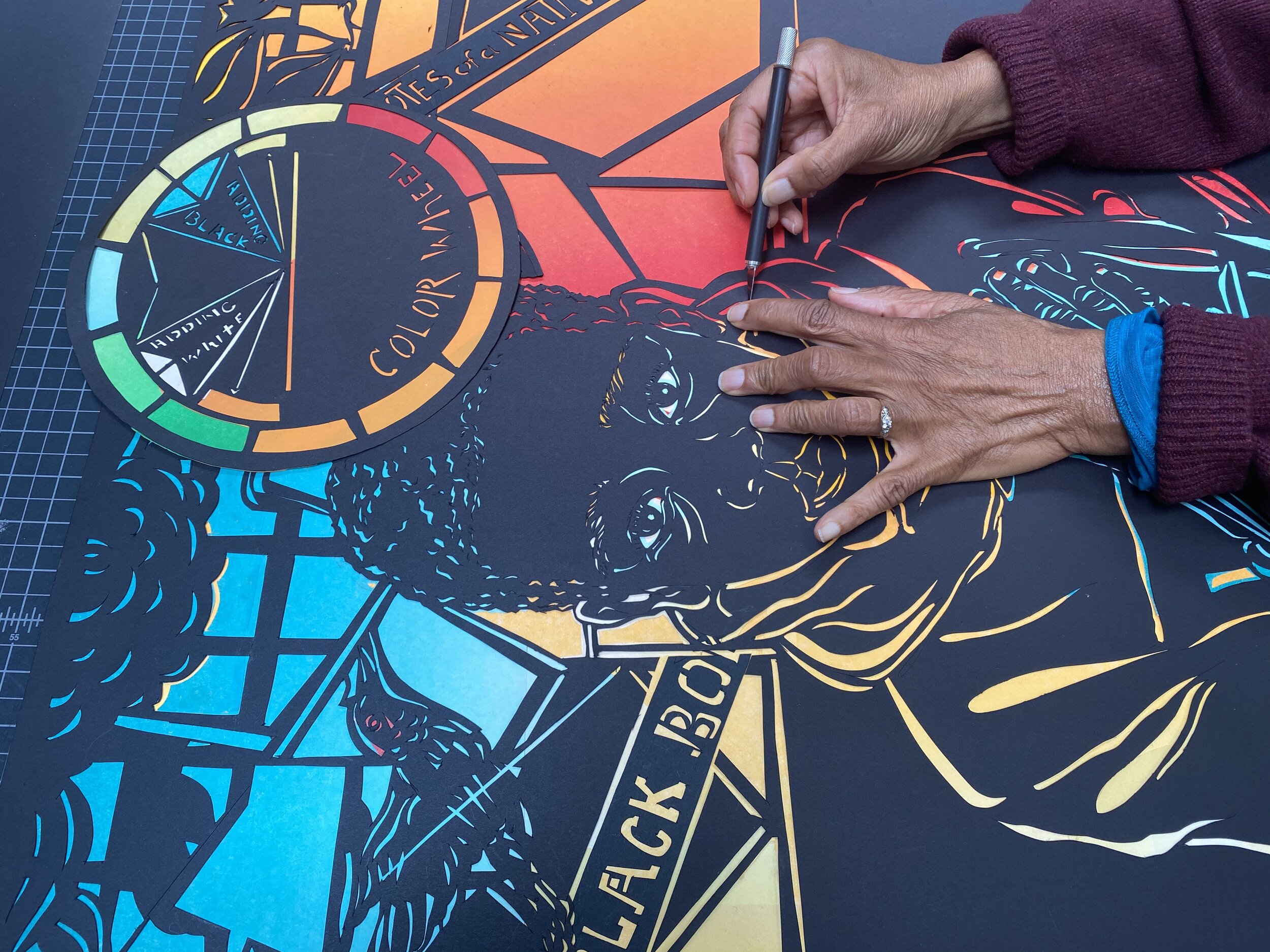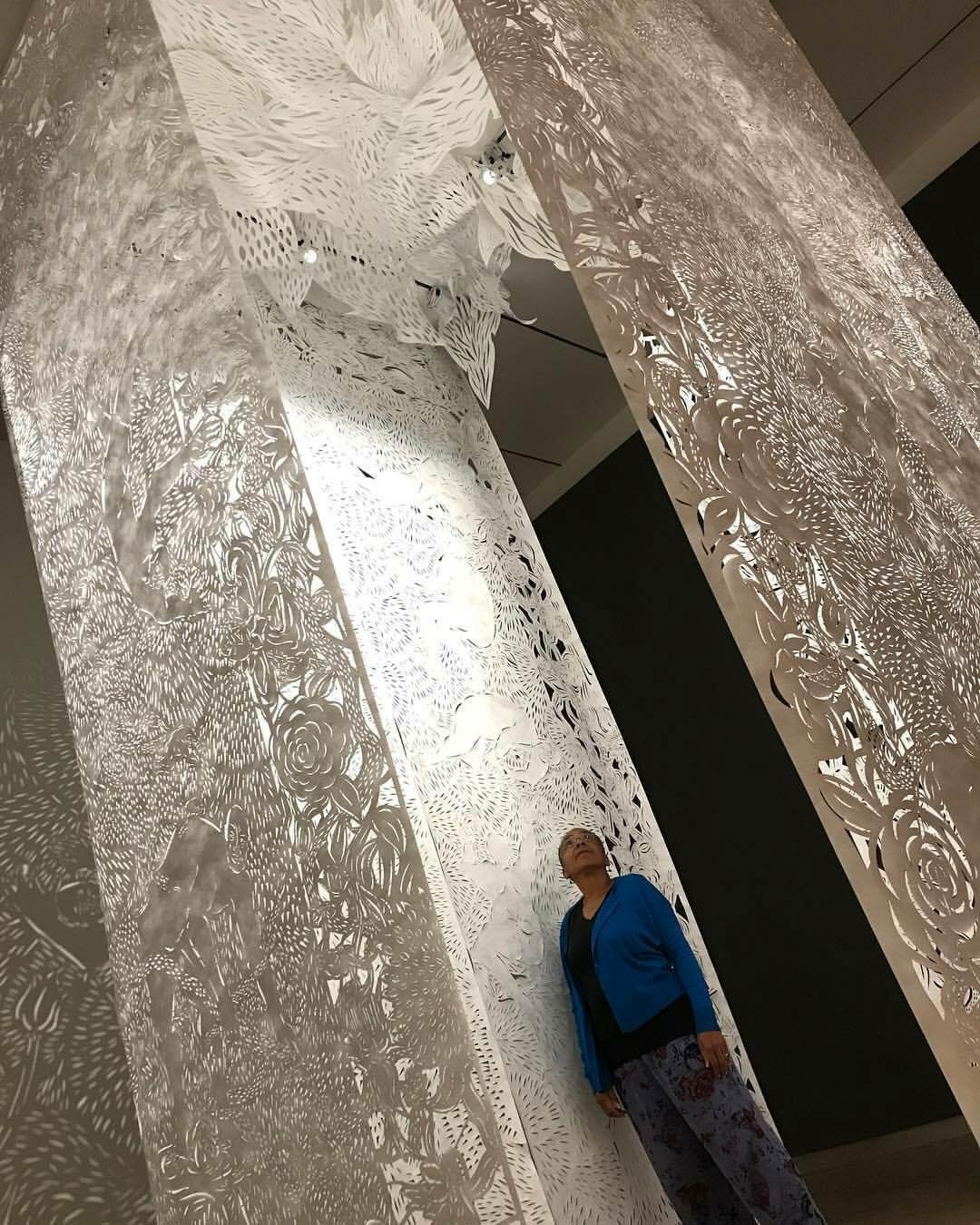Barbara Earl Thomas is a Seattle-based award-winning writer and visual artist with a career that spans more than 30 years. Describing her work, Thomas stated that, “It is the chaos of living and the grief of our time that compels me, philosophically, emotionally, and artistically. I am a witness and a chronicler: I create stories from the apocalypse we live in now and narrate how life goes on in midst of the chaos. A central question drives me: What is our responsibility as humans to each other, especially in times of tragedy, violence, death, natural or human disasters?” (source)
Her far-ranging exhibits include The Savannah Contemporary Art Museum and the Seattle and Tacoma Art Museums with solo exhibits at the Meadows Museum in Shreveport, Louisiana and the Evansville Museum of Art and Technology in Indiana. Her works, widely collected, are included in the Portland, Seattle and Tacoma Art Museums and private and corporate collections such as Microsoft, 21c Museum Hotel (Louisville, KY) and the Bill and Melinda Gates Foundation. Thomas has an upcoming solo exhibition at The Seattle Art Museum, set to open in November 2020. She is represented by the Claire Oliver Gallery, New York.
For more information, please see: http://barbaraearlthomas.com, https://www.claireoliver.com/artists/barbara-earl-thomas/ and on Instagram @barbaraearlthomas.
Thomas’ working on Color Wheel for her upcoming Seattle Art Museum exhibition. 2020. Image courtesy of Claire Oliver Gallery, New York.
Thomas’ current team of cutters, 2020. Image courtesy of the artist.
It's my experience that most artists engage with some level of self-isolation in their day to day art practice. Has this been your experience? And if so, have you found these innate rhythms to be helpful during this larger, world-wide experience of isolation?
Much of my work is solo, but in recent years I worked collaboratively with studio assistants, who help me create my large paper cut installations. When the pandemic hit, we disbanded, and I found their absence disorienting and I miss their energy.
It would be great if you could briefly talk us through your practice. Understanding it is integral to appreciating the multivalence of your work.
I’ve been working in my studio for more than 30 years – for me it’s a way of life centered on thinking, making and confronting whatever is my truth.
Barbara Earl Thomas, Holding Fire, 2019. Cut Tyvek and hand-rolled lithograph. 26 x 40 in | 66.0 x 101.6 cm. Image courtesy of Claire Oliver Gallery, New York.
Barbara Earl Thomas, Body Count (detail), 2018. Mouth Blown and Sandblasted Glass. 7 x 17 x 7 in | 17.8 x 43.2 x 17.8 cm. Image courtesy of Claire Oliver Gallery, New York.
Has any of your imagery shifted in a reflection to what's currently happening? And why, or why not?
My imagery has not shifted as it’s been figurative narrative telling and retelling the story of the Black condition in the context of the human condition of which we are all a part.
Are you thinking differently? Coping differently? Inspired differently?
My inspiration is the same – working to clarify what are my feelings and the truth of the moment.
What is bringing you solace, or even joy, in this moment?
Talking daily to my friends and loved ones. I read, write and listen to books.
Barbara Earl Thomas, Body Count, 2018. Mouth Blown and Sandblasted Glass. 7 x 17 x 7 in | 17.8 x 43.2 x 17.8 cm. Image courtesy of Claire Oliver Gallery, New York.
What research or writing are you doing that you find compelling?
Two years ago, when I was invited to show at the Seattle Art Museum, I’d just finished Junichiro Tanizaki’s In Praise of Shadows. His discussion of the Japanese esthetic with his interpretation of light and dark and what it says about value and beauty intrigued me. At the same moment I was re-reading an essay “Notes on White Supremacy” by James Hillman, written in 1986, for Spring Publications. His was a seminal work that helped me through a difficult work climate at the time.
Barbara Earl Thomas, Power Down, 2018. Cut Tyvek. 36 x 68 x 1 in | 91.4 x 172.7 x 2.5 cm. Image courtesy of Claire Oliver Gallery, New York.
Are you reading anything?
The Shadow of the Silk Road by Colin Thubron, And Sometimes I Wonder About You by Walter Mosley and re-reading Love in the Time of Cholera by Gabriel Garcia Marquez.
Barbara Earl Thomas, Bodies in a Matrix, 2017. Cut Tyvek. 120 x 168 x 144 in | 304.8 x 426.7 x 365.8 cm. The SCAD Museum of Art “Lines of Influence,” a group exhibition to commemorate the centennial celebration of Jacob Lawrence. Image courtesy of Claire Oliver Gallery, New York.







